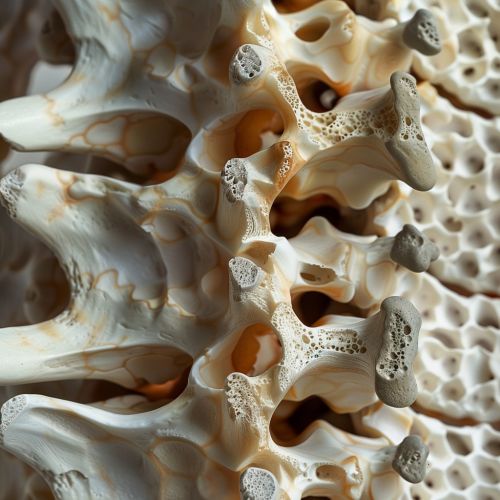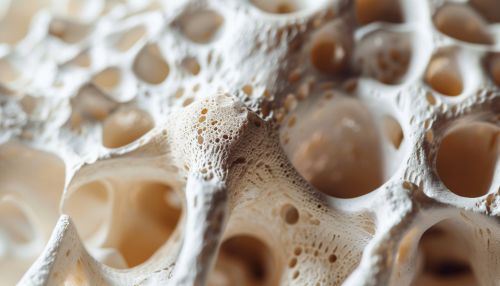Bone fracture
Introduction
A bone fracture is a medical condition where the continuity of the bone is broken. Fractures are commonly the result of high force impact or stress, but they can also occur as a result of certain medical conditions that weaken the bones, such as osteoporosis, certain types of cancer, or osteogenesis imperfecta. The severity of a fracture depends on the force that caused the break. If the bone's breaking point has been exceeded by a significant amount, the bone may shatter. If the force is slight, the bone may crack rather than break completely.
Types of Bone Fractures
Bone fractures can be classified in several ways, including by the nature of the break, the location of the fracture, and the cause of the break.
Simple vs. Compound Fractures
- Simple (Closed) Fracture: The bone is broken, but there is no puncture or open wound in the skin.
- Compound (Open) Fracture: The bone is broken and there is an open wound in the skin, which can lead to an increased risk of infection.
Complete vs. Incomplete Fractures
- Complete Fracture: The bone is broken into two or more pieces.
- Incomplete Fracture: The bone cracks but does not break all the way through.
Specific Types of Fractures
- Transverse Fracture: The break is in a straight line across the bone.
- Oblique Fracture: The break has a curved or sloped pattern.
- Spiral Fracture: The break spirals around the bone, common in a twisting injury.
- Comminuted Fracture: The bone is broken into several pieces.
- Greenstick Fracture: The bone cracks on one side only, not all the way through (common in children).
- Compression Fracture: The bone is crushed, causing the broken bone to be wider or flatter in appearance.
- Segmental Fracture: The same bone is fractured in two places, leaving a "floating" segment of bone.
- Avulsion Fracture: A fragment of bone is pulled off by a tendon or ligament.
Causes of Bone Fractures
Bone fractures can occur due to various reasons, including:
- Trauma: Such as falls, motor vehicle accidents, or sports injuries.
- Osteoporosis: A condition that weakens bones, making them more susceptible to breaking.
- Overuse: Repetitive motion can tire muscles and place more force on the bone, leading to stress fractures.
- Pathological Fractures: Fractures that occur in bones weakened by disease, such as cancer or osteogenesis imperfecta.
Symptoms of Bone Fractures
The symptoms of a bone fracture can vary depending on the location and severity of the break. Common symptoms include:
- Intense pain at the site of the fracture.
- Swelling, bruising, or tenderness around the injury.
- Deformity or an unusual angle of the limb or joint.
- Inability to bear weight on the affected area.
- Loss of function in the injured area.
- A grating sensation or sound (crepitus) if the broken ends of the bone rub together.
Diagnosis of Bone Fractures
Diagnosing a bone fracture typically involves a combination of physical examination and imaging studies.
Physical Examination
The healthcare provider will assess the injured area for signs of fracture, such as deformity, swelling, and tenderness. They may also check for any associated injuries, such as damage to blood vessels or nerves.
Imaging Studies
- X-rays: The most common and widely used method to diagnose fractures. X-rays can show the location, type, and severity of the fracture.
- CT Scans: Provide more detailed images and can help in assessing complex fractures.
- MRI: Useful for evaluating soft tissue injuries and stress fractures that may not be visible on X-rays.
- Bone Scans: Can detect stress fractures and other bone abnormalities.
Treatment of Bone Fractures
The treatment of bone fractures aims to ensure that the bone heals properly and to restore function to the affected area. Treatment options can vary depending on the type and location of the fracture.
Non-Surgical Treatment
- Casting and Splinting: Immobilizing the broken bone with a cast or splint to allow it to heal.
- Traction: Using a steady pulling action to align the bones.
- Bracing: Using a brace to support the bone during healing.
Surgical Treatment
- Internal Fixation: Using metal plates, screws, or rods to hold the bone fragments in place.
- External Fixation: Using a metal frame outside the body to stabilize the bone.
- Bone Grafting: Transplanting bone tissue to aid in the healing process.
Complications of Bone Fractures
While most bone fractures heal without significant issues, complications can occur, including:
- Infection: Particularly in open fractures where the bone has pierced the skin.
- Delayed Union: When the bone takes longer to heal than expected.
- Nonunion: When the bone fails to heal.
- Malunion: When the bone heals in an incorrect position.
- Compartment Syndrome: Increased pressure within a muscle compartment, which can lead to muscle and nerve damage.
- Fat Embolism: Fat globules released into the bloodstream, which can cause serious complications.
Rehabilitation and Recovery
Rehabilitation is a crucial part of the recovery process for bone fractures. It aims to restore function, strength, and mobility to the affected area.
Physical Therapy
Physical therapy may include exercises to improve range of motion, strength, and flexibility. Therapists may also use techniques such as massage, heat, and cold therapy to aid in recovery.
Occupational Therapy
Occupational therapy focuses on helping individuals perform daily activities and may include the use of adaptive devices.
Pain Management
Pain management strategies may include medications, such as nonsteroidal anti-inflammatory drugs (NSAIDs), and techniques such as ice application and rest.
Prevention of Bone Fractures
Preventing bone fractures involves addressing risk factors and taking steps to strengthen bones and improve overall health.
Lifestyle Modifications
- Diet: Consuming a diet rich in calcium and vitamin D to support bone health.
- Exercise: Engaging in weight-bearing exercises to strengthen bones.
- Avoiding Smoking and Excessive Alcohol: Both can weaken bones and increase the risk of fractures.
Medical Interventions
- Medications: Such as bisphosphonates for individuals with osteoporosis.
- Bone Density Testing: To assess bone health and identify individuals at risk for fractures.
See Also
References


